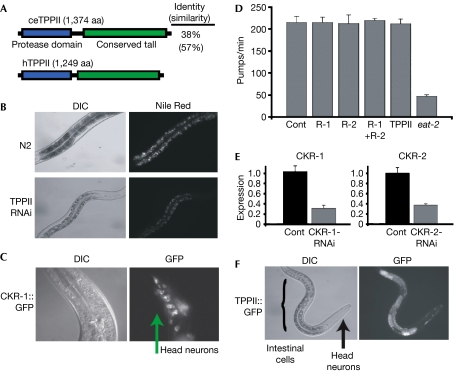Figure 1.
Analysis of Caenorhabditis elegans TPPII and cholecystokinin signalling. (A) Alignment of worm (ce) and human (h) TPPII. (B) TPPII double-stranded RNA was injected into N2 (wild-type) worms. F1 progeny were examined with DIC microscopy, which showed that TPPII-RNAi worms were paler, indicating decreased fat stores. The TPPII-RNAi and control worms were stained with Nile Red, a lipid-specific dye the emission intensity of which correlates with fat content, and photographed under fluorescence microscopy. Worms are at the same developmental stage. (C) CKR-1∷GFP transgenic worms were examined and the fluorescence pattern indicated that CKR-1 is expressed in a subset of neurons (arrow). (D) Analysis of feeding behaviour (pumps/min) following CKR-1 (R-1), CKR-2 (R-2), CKR-1+CKR-2 (R-1+R-2) and TPPII RNAi in an rrf-3, neural RNAi sensitized, background. The pumping rate of eat-2 mutant worms was measured as a positive control (Cont) for altered feeding behaviour. n=10, three replicates. (E) qPCR analysis of CKR-1 expression in CKR-1-RNAi (left panel) and CKR-2 expression in CKR-2-RNAi (right panel) worms and control (Cont). (F) A TPPII∷GFP transgene was expressed in the intestinal fat-storing cells (bracket) and a few head neurons (arrow). Error bars indicate s.d. CKR, cholecystokinin receptor; DIC, differential interference contrast; qPCR, quantitative PCR; RNAi, RNA interference; TPP, tripeptidyl peptidase.

